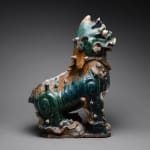Ming Glazed Terracotta Sculptures of a Fu Dog, 1368 CE - 1644 CE
Glazed Terracotta
height 45.7 cm
height 18 in
height 18 in
PF.1536A
Further images
The Fu Dog, or Fu Lion as it is also known, is a ubiquitous symbol that has been employed repeatedly throughout the history of China. Sometimes referred to as the...
The Fu Dog, or Fu Lion as it is also known, is a ubiquitous symbol that has been employed repeatedly throughout the history of China. Sometimes referred to as the “Dog of Happiness” or the “Celestial Dog,” the earliest traces of the Fu Dog in China date to the Han Dynasty (206 B.C.-220 A.D.). Then it disappeared from Chinese art until it was resurrected during the cultural revival experienced during the Tang Dynasty (618-906 A.D.). While lions are not native to China, works of art with lion imagery from other civilizations were imported into China as gifts for the Emperor. The Fu Lion was brought into China with the arrival of Buddhism, where it became associated with the more familiar dog during assimilation. The lion is a sacred creature in the Buddhist pantheon, and the Fu Lion was believed to be a companion of the Buddha.
Sculptures of Fu Dogs such as these outstanding blue and green-glazed examples originally stood guard outside of Buddhist temples. By the time of the Ming Dynasty, however, when this work was created, the Dogs had lost most of their religious significance and were placed outside the entrances to homes and palaces out of custom. Even today, many monumental public buildings are decorated with lion figures standing guard at the base of the stairway. Fu Dogs continue to be a popular symbol of luck and happiness.
Sculptures of Fu Dogs such as these outstanding blue and green-glazed examples originally stood guard outside of Buddhist temples. By the time of the Ming Dynasty, however, when this work was created, the Dogs had lost most of their religious significance and were placed outside the entrances to homes and palaces out of custom. Even today, many monumental public buildings are decorated with lion figures standing guard at the base of the stairway. Fu Dogs continue to be a popular symbol of luck and happiness.







